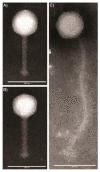Characterization of a Novel Group of Listeria Phages That Target Serotype 4b Listeria monocytogenes
- PMID: 33919793
- PMCID: PMC8070769
- DOI: 10.3390/v13040671
Characterization of a Novel Group of Listeria Phages That Target Serotype 4b Listeria monocytogenes
Abstract
Listeria monocytogenes serotype 4b strains are the most prevalent clinical isolates and are widely found in food processing environments. Bacteriophages are natural viral predators of bacteria and are a promising biocontrol agent for L. monocytogenes. The aims of this study were to characterize phages that specifically infect serotype 4b strains and to assess their ability to inhibit the growth of serotype 4b strains. Out of 120 wild Listeria phages, nine phages were selected based on their strong lytic activity against the model serotype 4b strain F2365. These nine phages can be divided into two groups based on their morphological characteristics and host range. Comparison to previously characterized phage genomes revealed one of these groups qualifies to be defined as a novel species. Phages LP-020, LP-027, and LP-094 were selected as representatives of these two groups of phages for further characterization through one-step growth curve and inhibition of serotype 4b L. monocytogenes experiments. Listeria phages that target serotype 4b showed an inhibitory effect on the growth of F2365 and other serotype 4 strains and may be useful for biocontrol of L.monocytogenes in food processing environments.
Keywords: Listeria monocytogenes; bacteriophage; phage; serotype 4b.
Conflict of interest statement
The authors declare no conflict of interest.
Figures







Similar articles
-
Isolation and relationship analysis of Listeria phages with various serotype hosts and morphological characterization.Virol J. 2025 Apr 18;22(1):104. doi: 10.1186/s12985-025-02706-w. Virol J. 2025. PMID: 40251606 Free PMC article.
-
Cross-resistance to phage infection in Listeria monocytogenes serotype 1/2a mutants.Food Microbiol. 2019 Dec;84:103239. doi: 10.1016/j.fm.2019.06.003. Epub 2019 Jun 5. Food Microbiol. 2019. PMID: 31421769
-
Longitudinal monitoring of Listeria monocytogenes and Listeria phages in seafood processing environments in Thailand.Food Microbiol. 2017 Sep;66:11-19. doi: 10.1016/j.fm.2017.03.014. Epub 2017 Mar 21. Food Microbiol. 2017. PMID: 28576358
-
[Bacteriophages and bacteriocins of the genus Listeria].Zentralbl Bakteriol Mikrobiol Hyg A. 1986 Feb;261(1):12-28. Zentralbl Bakteriol Mikrobiol Hyg A. 1986. PMID: 3085381 Review. French.
-
Bacteriophage biocontrol to fight Listeria outbreaks in seafood.Food Chem Toxicol. 2020 Nov;145:111682. doi: 10.1016/j.fct.2020.111682. Epub 2020 Aug 15. Food Chem Toxicol. 2020. PMID: 32805341 Review.
Cited by
-
Isolation and Characterization of vB_kpnM_17-11, a Novel Phage Efficient Against Carbapenem-Resistant Klebsiella pneumoniae.Front Cell Infect Microbiol. 2022 Jul 5;12:897531. doi: 10.3389/fcimb.2022.897531. eCollection 2022. Front Cell Infect Microbiol. 2022. PMID: 35865823 Free PMC article.
-
Isolation and characterization of bacteriophages for combating multidrug-resistant Listeria monocytogenes from dairy cattle farms in conjugation with silver nanoparticles.BMC Microbiol. 2023 May 22;23(1):146. doi: 10.1186/s12866-023-02893-y. BMC Microbiol. 2023. PMID: 37217869 Free PMC article.
-
Characterization and Preliminary Application of Phage Isolated From Listeria monocytogenes.Front Vet Sci. 2022 Jul 20;9:946814. doi: 10.3389/fvets.2022.946814. eCollection 2022. Front Vet Sci. 2022. PMID: 35990275 Free PMC article.
-
Listeria monocytogenes and Listeriosis: The Global Enigma.Foods. 2025 Apr 3;14(7):1266. doi: 10.3390/foods14071266. Foods. 2025. PMID: 40238523 Free PMC article. Review.
-
Isolation and Characterization of Two Novel Lytic Bacteriophages against Salmonella typhimurium and Their Biocontrol Potential in Food Products.Foods. 2024 Sep 28;13(19):3103. doi: 10.3390/foods13193103. Foods. 2024. PMID: 39410138 Free PMC article.
References
-
- Karthikeyan R., Gayathri P., Gunasekaran P., Jagannadham M.V., Rajendhran J. Comprehensive proteomic analysis and pathogenic role of membrane vesicles of Listeria monocytogenes serotype 4b reveals proteins associated with virulence and their possible interaction with host. Int. J. Med. Microbiol. 2019;309:199–212. doi: 10.1016/j.ijmm.2019.03.008. - DOI - PubMed
Publication types
MeSH terms
Substances
LinkOut - more resources
Full Text Sources
Other Literature Sources

